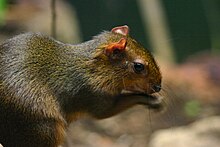Acouchi
| Acouchis Temporal range:
| |
|---|---|

| |
| Green acouchi, Myoprocta pratti | |
| Scientific classification | |
| Domain: | Eukaryota |
| Kingdom: | Animalia |
| Phylum: | Chordata |
| Class: | Mammalia |
| Order: | Rodentia |
| Family: | Dasyproctidae |
| Genus: | Myoprocta Thomas, 1903 |
| Species | |
The acouchis (genus Myoprocta) are rodents belonging to the family Dasyproctidae from the Amazon basin. They are generally smaller than agoutis and have very short tails (5 to 7 cm), while agoutis lack tails.[1] For this reason the acouchis are also called tailed agoutis.[citation needed]
The two species — the red acouchi (M. acouchy) in the Guianas of Amazonia and nearby parts of Brazil, and the green acouchi (M. pratti) in western Amazonia - differ in coloration and other characteristics. The taxonomy of the genus has historically been confused, with some authors applying the "M.acouchy" name to the green acouchi, in which case the red acouchi is called M. exilis. Although this issue has now been resolved, other problems remain; in particular, the green acouchi may include more than one species.[2]
They are coloured brown or greenish, but with bright orange or red parts on their heads. Often, acouchis live in riverbanks, where they dig holes. Like the common agoutis, but unlike the much larger pacas, acouchis are active at day and feed on fruit.
Acouchis depend on their tails to convey their willingness and readiness to mate. Confident, ready males will hold their tails erect and begin to wag them, whereas the more timid, but still aroused, males will wag their tails in a downward position. Females will signal their interest by erecting their tails while simultaneously arching their backs downward. The litter size is generally two.
References
Literature cited
- Voss, R.S., Lunde, D.P. & Simmons, N.B. 2001. Mammals of Paracou, French Guiana: a Neotropical lowland rainforest fauna. Part 2. Nonvolant species. Bulletin of the American Museum of Natural History 263:1-236.
